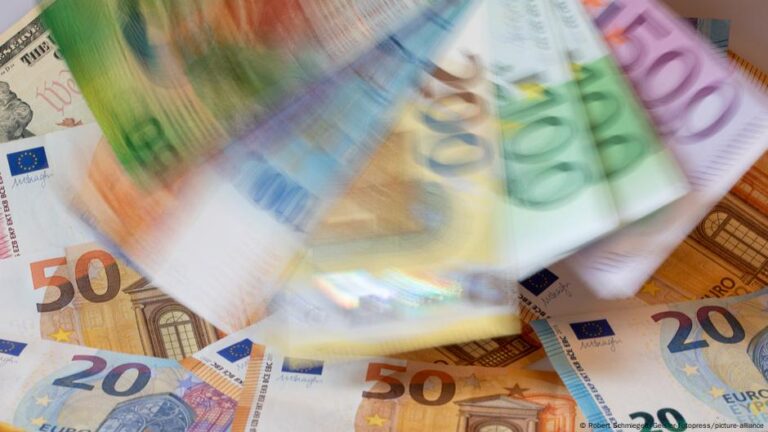The euro has surged over 10% against the US dollar since January, reaching 1.1369 dollars per euro on Monday (April 14).
While much of the euro’s rally stems from a flight from the dollar due to US President Donald Trump’s protectionist trade policies — including steep tariffs of 145% on China — part of the single currency’s strength reflects growing confidence in the eurozone economy.
The 20-member eurozone is rebounding from a mild recession in 2023, with growth of 0.8% last year and a projected 1.3% expansion in 2025. However, looming 20% US tariffs on imports from the European Union — currently paused for 90 days — could still derail this outlook.
Anticipating a European recovery amid US economic uncertainty, many foreign investors are shifting capital from the dollar into European stocks and bonds, further bolstering the euro’s value.
US-eurozone interest rate gap widens
The euro’s strength is also being fueled by diverging monetary policies. While the US Federal Reserve has begun cutting interest rates, theEuropean Central Bank (ECB) remains hawkish in response to stubborn inflation in parts of the eurozone. Lower US interest rates make holding dollars less profitable, prompting investors to favor the euro instead.
Even so, major currency swings of 10% in mere months are relatively rare and the euro is increasingly being seen as a counterweight to the dollar during these turbulent geopolitical times, as fears grow that Trump’s tariffs could tip the US economy into recession.
“Trump is undermining trust in the rationality of US policymaking, the long-term outlook for US growth and the sustainability of its public finances,” Holger Schmieding, chief economist at Berenberg Bank, told DW. “As a result, the dollar is losing some of its value, but the euro is no real alternative.”
Schmieding cited the damage Trump’s trade agenda could do to the global economy, which he said “could weigh on eurozone growth and require the ECB to respond with more rate cuts.”
Oxford Economics estimates that if Trump proceeds with 20% tariffs on EU exports, eurozone growth could decline by up to 0.3 percentage points this year and next. The projection assumes Brussels would respond with targeted countermeasures on US goods rather than full-scale retaliation.
Germany’s €1 trillion stimulus boosts confidence
Germany’s massive defense, infrastructure and climate protection spending package, approved by parliament earlier this month, involves a significant €1 trillion ($1.13 trillion) in fiscal stimulus over the next decade.
The announcement has further bolstered investor confidence in the euro, reinforcing the currency’s recent rally by signaling long-term economic support at the heart of the eurozone.
Much of the German spending will be financed via new bonds, which pushes up yields, drawing in foreign investors. Commerzbank, Germany’s second-largest lender, predicts the country’s debt ratio could rise to 90% of gross domestic product (GDP) over the next decade, which would make euro-denominated assets more alluring.
“The additional public borrowing will make the short end of the German fixed income market [short-term bonds] a bit deeper and more liquid and hence more attractive,” Schmieding told DW.
Goldman Sachs last month projected the massive stimulus would boost Germany’s GDP by a full percentage point next year and boost eurozone growth by 0.2% percentage points.
“One reason is that we expect stronger growth in Germany to spill over into neighboring countries,” Goldman Sachs Research Chief European Economist Sven Jari Stehn wrote. “Another reason is that we now expect the rest of the euro area to step up military spending somewhat more quickly in response to the German announcement.”
France, Italy and Spain are expected to boost defense spending closer to 3% of GDP over the next two years.
Could joint bonds help the euro?
Given these ambitious military spending plans, Rebecca Christie, a senior fellow at the Brussels-based think tank Bruegel, joined the growing call for the issuing of joint eurozone debt, often referred to as eurobonds.
“Joint bonds are a strength worth boosting — creating a follow-on program to the post-pandemic recovery plan would raise money and encourage the world to trade in euros,” Christie, a former ECB economist, said.
She was referring to the €750 billion stimulus package launched after the COVID-19 pandemic, more than half of which was financed through joint bonds — an unprecedented move by the EU.
The creation of eurobonds is supported by southern EU states but opposed by northern EU members, including Germany.
Pros and cons of a stronger euro
The current strength of the single currency is, for now, a boon to consumers and businesses who can buy American-made products at lower prices — although many Europeans are boycotting US goods, blaming Trump’s aggressive trade moves.
Tourism to the US from Europe has also become a bit cheaper, while commodities priced in dollars, like oil and gas, have become more affordable. This is a welcome relief for eurozone manufacturers still grappling with high energy costs from Russia’s full-scale invasion of Ukraine.
Christie noted that European airlines and militaries could also benefit from cheaper prices for new planes, which are also purchased in dollars.
“At the same time, some European exporters may feel the effects of their goods becoming a bit more expensive for the rest of the world,” she said.
Germany is seen as the most vulnerable to the euro’s strength, as exports accounted for around half of its GDP last year.
A stronger currency makes German cars, machinery, and chemicals more costly at a time when Europe’s largest economy is already struggling with high energy prices, weak global demand and intense competition from China.
While some currency traders predict the euro could further strengthen against the greenback before the end of the year, most major investment banks predict it will hover around its current level.
“Everything is extremely uncertain right now, and it’s unclear if the euro will keep rising against the dollar or level out. For the moment, it’s still within its historical range,” Bruegel’s Christie told DW.
Edited by: Uwe Hessler


